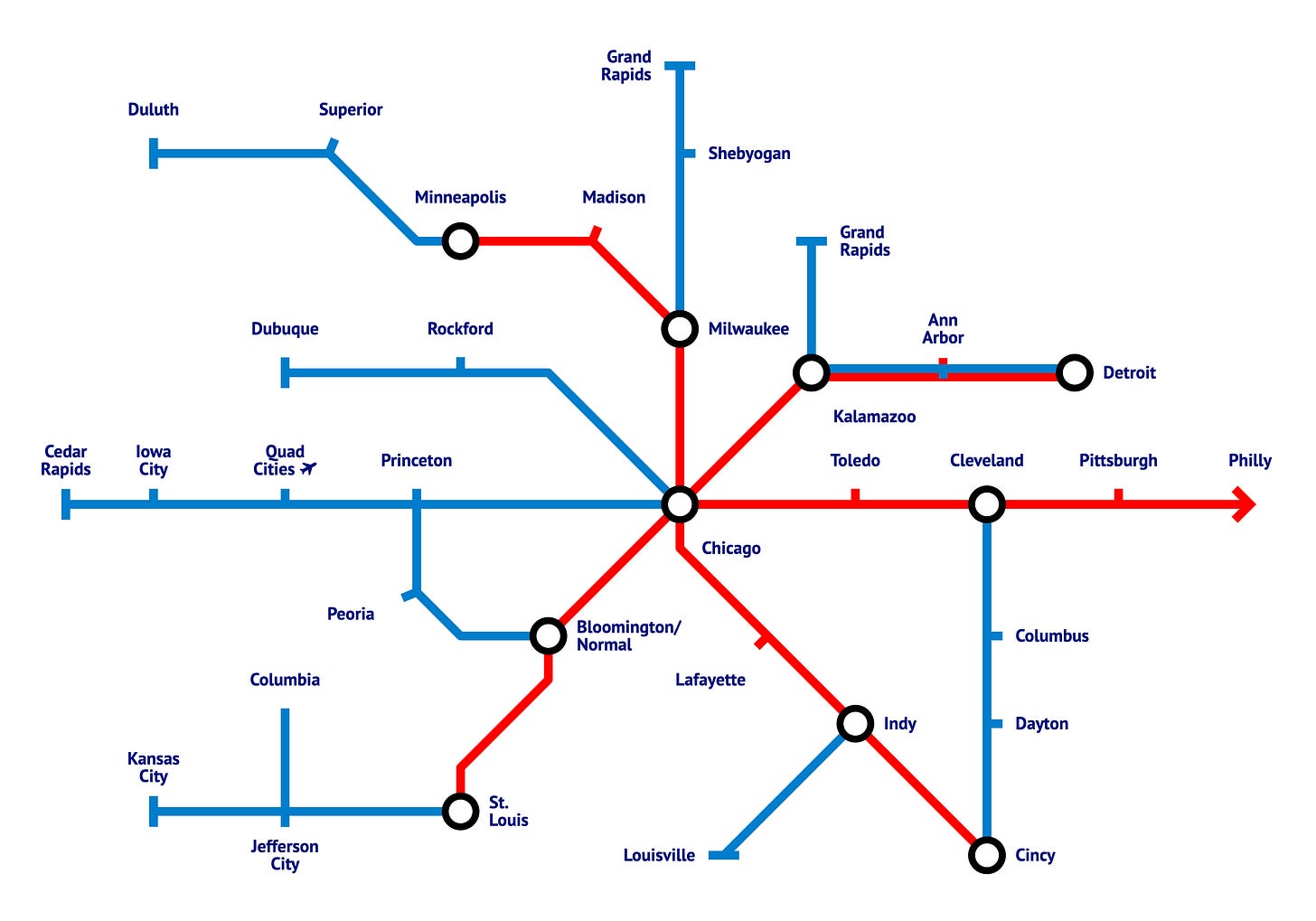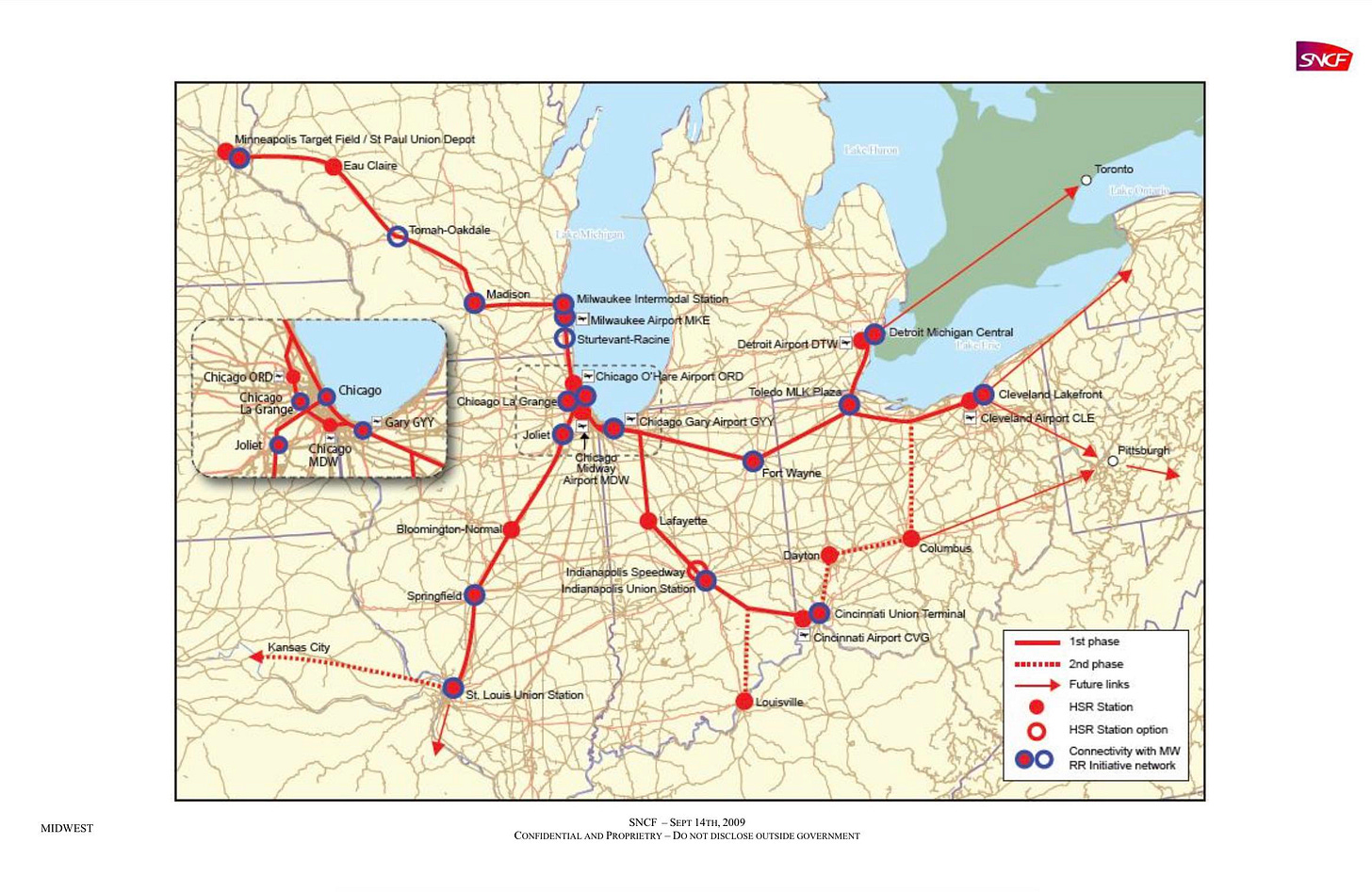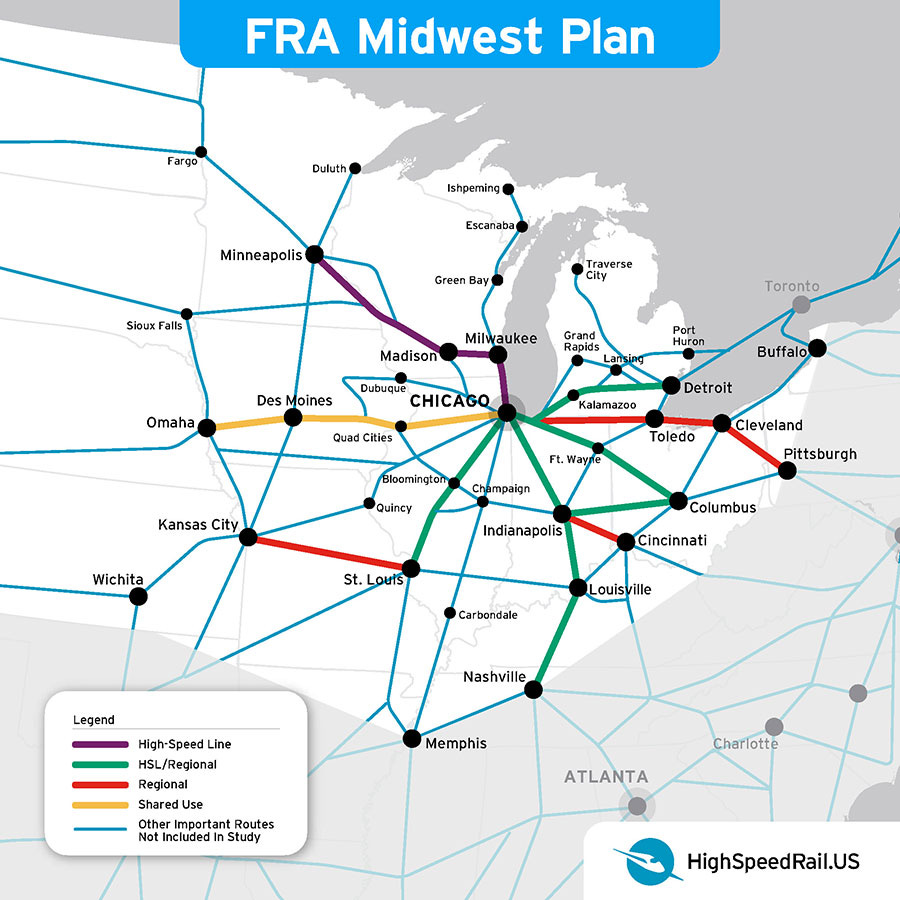I Asked ChatGPT to Build a Rail System for the Midwest (It Kind of Did)
What an AI rail plan says about how small our infrastructure dreams have become.
(Correction: Green Bay shows on the proposed system map as Grand Rapids; my apologies for the oversight)
You’re standing in one of the most beautiful train halls in the country, Chicago’s Union Station. You look up at the departure board, and it rivals a major European hub: six METRA lines, nineteen Amtrak routes, plus nine new regional lines and five “higher-speed” trunks stretching across the Midwest and to the Mid Atlantic.
All of them, fully imagined, engineered, and scheduled, were designed by ChatGPT.
The prompt was as follows:
If you had unlimited money, political will, and the ability to build and operate a comprehensive intercity rail system in the Midwest, without it being a crazy fantasy, what is the best plan you could pursue without veering into anything politically crazy?
I wanted to test what happens when you give AI a real planning challenge, not to fantasize, but to see how it thinks about tradeoffs, geography, and feasibility.
Because here’s the thing: the public transit industry is wildly complacent. In 2025, we’re still not seriously talking about how tools like AI could transform how we plan and operate transit systems. I’m not an AI evangelist, but I do see its value in research, medicine, logistics, and yes, slashing the endless, bureaucratic paper-pushing that slows real progress.
For this exercise, I let the model lead and make all decisions. I asked clarifying questions but didn’t interfere, even when it offered options. For instance, when it proposed multiple alignments between Indianapolis and Cincinnati, I asked it to pick the best one and went with that, no edits.
The Plan:
ChatGPT’s proposal is surprisingly structured. It outlines a Midwest-wide rail network built around:
5 “higher-speed” trunk lines connecting major city pairs (up to 125 mph), and
9 regional intercity lines linking medium-sized cities into that backbone.
Everything runs on diesel (more on that later).
Trunk Lines
The five “Higher-Speed” trunks are limited-stop corridors connecting the Midwest’s biggest metros, with express and semi-fast patterns to balance speed and coverage.
Service classes:
Express – Skips most intermediates, aiming for airline-competitive travel times.
Semi-fast – Adds key regional stops without wrecking the schedule.
Infrastructure Approach
Mostly upgraded legacy mainlines where geometry allows, with select new greenfield segments and grade-separated approaches in bottleneck areas.
The Intercity Regional Routes:
H1 — Chicago ⇄ Detroit (Windsor/Canada ready)
The “Michigan Spine.” Fast “Wolverine” corridor via Kalamazoo and Ann Arbor, continuing through a new cross-border link to Windsor, keeping the door open for a future Toronto connection.
H2 — Chicago ⇄ Philadelphia (via Toledo, Cleveland, Pittsburgh, Harrisburg)
The long Midwestern–Keystone corridor: higher-speed running on straight freight mains west of Pittsburgh, then a quick, electrics-friendly dash across Pennsylvania to 30th Street, our best one-seat to the Northeast without NYC complexity.
H3 — Chicago ⇄ Twin Cities (via Milwaukee, Madison, Eau Claire)
Northwest flagship: upgrades on the existing Chicago–Milwaukee line, a new fast link through Madison and Eau Claire, and direct downtown-to-downtown travel into St. Paul/Minneapolis.
H4 — Chicago ⇄ St. Louis (Upgraded Amtrak Lincoln Service)
Take today’s Lincoln corridor improvements and finish the job: full double-tracking, higher speeds, and grade separations via Joliet, Bloomington–Normal, Springfield, and Alton.
H5 — Chicago ⇄ Indianapolis ⇄ Cincinnati
South-southeast arrow: targeted new build where the legacy geometry is curvy, smooth approaches into Indy and Cincy.
Regional Intercity Lines
Nine frequent regional routes tie together secondary cities, freight corridors, and universities, feeding the main trunks.
Service: Clockface (hourly or every two hours), consistent stopping, reliability prioritized over top speed.
Infrastructure: Freight-compatible upgrades — better signals, passing sidings, selective grade separations, and modest downtown stations.
R1 — Cleveland–Columbus–Dayton–Cincinnati (3C+D)
R2 — Detroit–Kalamazoo–Grand Rapids (spur off H1)
R3 — Chicago–Rockford–Freeport–Dubuque
R4 — Chicago–Iowa City–Cedar Rapids
R5 — Chicago–Peoria–Bloomington/Normal
R6 — Twin Cities–Duluth/Superior
R7 — St. Louis–Kansas City (+ Columbia spur)
R8 — Indianapolis–Louisville
R9 — Milwaukee–Sheboygan–Manitowoc–Green Bay
ChatGPT assumes roughly 80% of the routes use existing rail right-of-way (ROW) — only two trunk lines need substantial new build segments, mostly along highway medians outside Chicagoland.
It doesn’t weigh freight ownership or political feasibility; it simply avoids corridors it deems “too busy” for shared passenger use, therefore requiring a new greenfield ROW.
For service frequency, the model is aggressive:
At least every two hours on all routes,
More frequent than nearly any U.S. commuter line,
Service span: 5:00 AM to 11:00 PM in both directions.
Each trunk line includes both Express and Semi-fast services; regional routes run one consistent pattern.
I then asked ChatGPT to estimate the full cost of the system: everything from sidings, flyovers, and signal upgrades to track renewals, fleet purchases, and new station construction. It produced a detailed breakdown, and I also asked it to compare those numbers to what the same network would cost to build in Spain or Italy, two countries known for delivering world-class rail at a fraction of U.S. prices.
If you want to dig deeper, ChatGPT even generated timetables for every route, with each line in its own tab, a surprisingly comprehensive output for something built entirely by AI. HERE
My Thoughts on the System Plan
When asked about its own shortcomings, ChatGPT pointed out three:
A) uneven ambition: some routes need full rebuilds, others minimal work;
B) an all-diesel system
C) limited accounting for Chicago’s congestion and bottlenecks.
All fair points, I might add.
There’s not a single corridor in its plan that doesn’t deserve rail. It nailed the fundamentals, the right city pairs, the right connections, but it also left out a few routes that should’ve been included, especially given how many corridors the Biden Administration’s Corridor ID program already recognized.
That said, proposing a non-electrified “higher-speed” network that requires hundreds of new miles of track and full grade separation is, frankly, silly. If you’re spending tens of billions, maybe even over $100 billion, why wouldn’t you electrify? The SNCF’s 2009 Midwest plan achieved faster travel times with similar coverage, and that was over a decade ago.
Service levels are where the model overreaches. The ambition is great: frequent, clockface service across the board, but not every corridor needs trains every 30 minutes for 17 hours a day. Some routes could comfortably run hourly and still deliver a world-class level of service.
Side Note: Cincinnati would go from 3 round-trips per week to 252
Still, the projected travel-time cuts are impressive: 30% to 70% faster on the five main corridors compared to today. That’s huge. But again, it circles back to the same question, if we’re already spending this much and building this extensively, why settle for diesel?
Overall, I’d give the plan a C+ to B-. The coverage is solid, the ambition refreshing, and the logic mostly sound. But it’s uneven. The lack of electrification undercuts the entire premise, and while a Chicago–Philadelphia link makes sense in theory, a ten-hour trip isn’t competitive without true 220 mph speeds. Chicago may always be the rail hub of the Midwest, but a truly visionary plan should’ve gone further, connecting regions, not just endpoints.
My Thoughts on ChatGPT’s Approach
For starters, ChatGPT didn’t recognize that many of the rail lines it used were abandoned or converted into rail trails. I had to point that out, which, of course, would completely change its proposed alignments.
The model bases its plans on what it thinks is politically feasible, but it doesn’t account for the real-world complexity of freight ownership, right-of-way control, or public opposition. In reality, some of the alignments it chose would be nearly impossible to implement without detailed alternatives and extensive environmental review.
It’s also highly sensitive to prompt scope. When I asked it for a Midwest plan, it produced a broad, minimal network. But when I swapped “Midwest” for “Illinois,” it generated a far more detailed intercity system with multiple in-state routes, a reminder that the framing of the question defines the boundaries of its imagination.
Where it struggles most is context. It reads geography like a flat map, two-dimensional. For instance, it suggested a “12-mile urban connector” on the western approach to Cincinnati without realizing there’s already a parallel existing rail corridor nearby and the terrain is tough for a passenger train. It often stitches together lines owned by different freight operators without considering whether they even connect in reality. That lack of spatial and ownership context makes its plans technically neat but incoherent from an implementation perspective.
Last Thoughts
I think it’s genuinely exciting to see what AI can do in this space, especially in an era where public infrastructure planning feels stuck. No, people shouldn’t lose their jobs to this technology. But yes, we should use it to complement how we plan, analyze, and produce transit. AI can expand our output and challenge complacency, especially in an industry bogged down by bureaucracy and legacy vendors.
In the end, the FRA Midwest Plan is still the far superior vision, and I wish ChatGPT had produced something closer to it. But perhaps that’s the point. Within its cautious, unimaginative system, it accidentally revealed something deeper about us: not the country we could be, but the one we’ve become.





